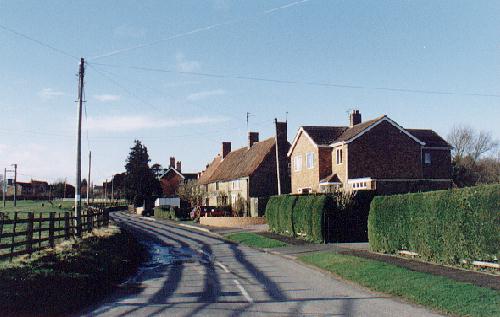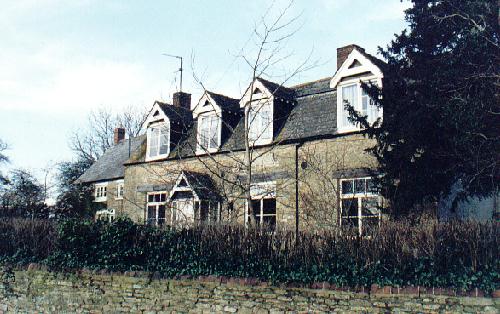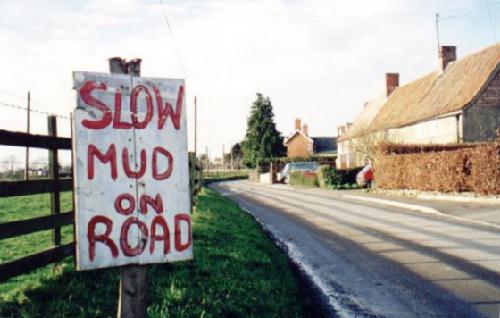|
Stainfield

South Lincolnshire is full of hamlets, tucked away in isolated locations, but still full of interest and often of mystery. Stainfield is just off the A15 three miles north of Bourne and is little more than a few houses dotted around a crossroads but is part of Haconby parish, two miles to the east on the other side of the main road, and in past centuries it was known as Hacconby with Stenfield (sic).
It is reputedly the site of a particularly violent skirmish while the Vikings were trying to establish a foothold in England after their hunting economy collapsed in Scandinavia and they were seeking pastures new. The east coast of England was a favourite destination for the long boats during the 8th and 9th centuries although their invasions were repelled by the Saxon inhabitants and the confrontation that took place here left the field where the opposing parties met stained with blood, hence the name.
However, this is probably only local legend because the name Stainfield actually originated from
Steinstone which was mentioned in the Domesday Book of 1086 and by 1202 this had become
Steynthweyt meaning "the clearing on stony ground", from the Old English stein and the Old Norse
thveit. There is some confusion in these early spellings but the thveit in the name was certainly replaced by field by the end of the 17th century and so there may be a grain of truth in the old legend that has been passed down the years by oral tradition and will most certainly be recounted by those who live there now.
Many Roman coins have also been found in the locality because Stainfield was once the site of a Roman station and then in 1720, Dr Edward Greathead of Lincoln discovered the existence of chalybeate springs in the vicinity and a well house was built for the convenience of the many visitors. The water was noted for its remarkable purity and abundance of gaseous constituents, rending it eminently suitable for drinking and for dietetic purposes. It was also reputed to exert a beneficial action, used externally for certain affections of the skin but the venture was short-lived and today, only the name Spa Farm remains to remind us of it.
The village once had a chapel together with a post office, both now closed. There was also a National School, built in 1866 by Lord Aveland for 80 children and with an average attendance of 50 and supported by a voluntary rate but this closed during the middle of the 20th century and the premises have been converted for use as a private house although the school crest can still be seen on the wall. In 1885, the poor from Stainfield hamlet shared out £47 6s 2d every year, the interest from a bequest left by Henry Fryer in 1822.
There is also evidence that Stainfield was once the home of several prominent Roman Catholic families at a time of Protestant rule in England when non attendance at church was a civil offence punishable by heavy fines, a situation that led to Robert Catesby initiating the Catholic conspiracy to blow up the Houses of Parliament and assassinate James I, known today as the Gunpowder Plot. The Catholics became the largest group of non-attenders, centred on Irnham, and in 1676 a total of 56 recusants were recorded in the area at Corby Glen, Lound, Haconby and Stainfield.
One of the largest properties in the village is Stainfield House, pictured above, distinguished by its four distinctive dormer windows, and may well have been the home of such a family because there is evidence of 17th century occupation and perhaps even earlier. The present deeds of the house date from 1888 but its prominent location indicates that it has been the site of a large house, and therefore the home of an important local family, for several centuries.
The roads through Stainfield are narrow and treacherous during the autumn and winter, mainly because of mud on the surface left there by farmers using tractors and agricultural equipment with no regard for either the Highway Code or other road users and such hazardous conditions are a particular deterrent to motorists during very wet weather. The culprits appear to think that the posting of a notice by the roadside, as pictured above, expiates their sins but the act remains illegal.
There is another Stainfield in the north of Lincolnshire, four miles from Bardney, and the two are often mistakenly identified.
|
FROM THE ARCHIVES
Richard Callis, a farmer and freeholder, of
Stainfield, near Bourne, commonly called the Old Duke, was buried. This
man was just and honest all can tell, and much lamented at his last
farewell.
- from the parish registers for Haconby, 19th October 1704.
We hear from the Spa at Stainfield, near Bourne, that there is a great
deal of agreeable company, among which are the Lady Ray, the Lady Hales
the Elder, Sir Christopher Hales and his Lady, the beautiful Miss Hales,
the two agreeable Miss Wigleys, Miss Caldico and Miss Tyrwit, the
beautiful Miss Fowler, the two polite and genteel Miss Robinsons and the
good natured Miss Breacknock; Mrs Toller, Mrs Brown, Mrs Preston, Mrs
Nevil, and Mrs Bagnal; the Dean of Lincoln and his daughter, the Rev Mr
Bertie, the Rev Mr Terry, the Rev Mr Howson, and the Rev Mr Bradfield: Mr
Tod, Mr Berridge, Mr and Mrs Hartop, Mr Pert, Mr Cheselden, Mr Litchforde,
Mr and Mrs Shaw, and three agreeable young Misses, and Mr Dumfresnoue; and
other persons of distinction are daily expected. - news item from the
Stamford Mercury, Thursday 27th July 1738.
Stainfield Spa near Bourne in Lincolnshire is now open for the season
and the waters in the greatest perfection. There are also accommodations
for persons of distinction at the house of William Hides, who always
attends at the Spa.
N B: Any person who fetches the water to serve persons that cannot come to
the Spa may have it for threepence a gallon. And a ticket will be
delivered to every person that fetches the said water by the Master of the
Spa. - notice from the Stamford Mercury, Thursday 16th June 1743. |
REVISED AUGUST 2013

Go to:
Main Index Villages
Index
|


